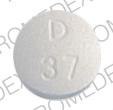Demerol Injection Dosage
Generic name: MEPERIDINE HYDROCHLORIDE 50mg in 1mL
Dosage form: injection, solution
Drug class: Opioids (narcotic analgesics)
Medically reviewed by Drugs.com. Last updated on Apr 5, 2024.
Important Dosage and Administration Instructions
- •
- DEMEROL Injection should be prescribed only by healthcare professionals who are knowledgeable about the use of opioids and how to mitigate the associated risks.
- •
- Use the lowest effective dosage for the shortest duration of time consistent with individual patient treatment goals [see Warnings and Precautions (5)]. Because the risk of overdose increases as opioid doses increase, reserve titration to higher doses of DEMEROL Injection for patients in whom lower doses are insufficiently effective and in whom the expected benefits of using a higher dose opioid clearly outweigh the substantial risks.
- •
- Many acute pain conditions (e.g., the pain that occurs with a number of surgical procedures or acute musculoskeletal injuries) require no more than a few days of an opioid analgesic. Clinical guidelines on opioid prescribing for some acute pain conditions are available.
- •
- There is variability in the opioid analgesic dose and duration needed to adequately manage pain due both to the cause of pain and to individual patient factors. Initiate the dosing regimen for each patient individually, taking into account the patient's underlying cause and severity of pain, prior analgesic treatment and response, and risk factors for addiction, abuse, and misuse [see Warnings and Precautions (5.1)].
- •
- Respiratory depression can occur at any time during opioid therapy, especially when initiating and following dosage increases with DEMEROL Injection. Consider this risk when selecting an initial dose and when making dose adjustments [see Warnings and Precautions (5)].
- •
- Inspect DEMEROL Injection for particulate matter and discoloration prior to administration. Do not use if color is darker than pale yellow, if it is discolored in any other way, or if it contains a precipitate.
For Management of Pain
Initial Dosage
Dosage should be adjusted according to the severity of the pain and the response of the patient. While subcutaneous administration is suitable for occasional use, intramuscular administration is preferred when repeated doses are required. If intravenous administration is required, dosage should be decreased and the injection made very slowly, preferably utilizing a diluted solution.
Adults: Initiate treatment in a dosing range of 50 mg to 150 mg intramuscularly or subcutaneously every 3 to 4 hours as needed for pain, and at the lowest dose necessary to achieve adequate analgesia. Elderly patients should usually be given meperidine at the lower end of the dose range and observed closely.
Titration and Maintenance of Therapy
Titrate the dose based upon the individual patient’s response to their initial dose of DEMEROL Injection. Individually titrate DEMEROL Injection to a dose that provides adequate analgesia and minimizes adverse reactions. Continually reevaluate patients receiving DEMEROL Injection to assess the maintenance of pain control, signs and symptoms of opioid withdrawal, and other adverse reactions, as well as to reassess for the development of addiction, abuse, or misuse [see Warnings and Precautions (5.1, 5.15)]. Frequent communication is important among the prescriber, other members of the health and care team, the patient, and the caregiver/family during periods of changing analgesic requirements, including initial titration.
If the level of pain increases after dosage stabilization, attempt to identify the source of increased pain before increasing the DEMEROL Injection dosage. If after increasing the dosage, unacceptable opioid-related adverse reactions are observed (including an increase in pain after a dosage increase), consider reducing the dosage [see Warnings and Precautions (5)]. Adjust the dosage to obtain an appropriate balance between management of pain and opioid-related adverse reactions.
Discontinuation of DEMEROL Injection
When a patient who has been taking DEMEROL Injection regularly and may be physically-dependent no longer requires therapy with DEMEROL Injection, taper the dose gradually, by 25% to 50% every 2 to 4 days, while monitoring carefully for signs and symptoms of withdrawal. If the patient develops these signs or symptoms, raise the dose to the previous level and taper more slowly, either by increasing the interval between decreases, decreasing the amount of change in dose, or both. Do not abruptly discontinue DEMEROL Injection in a physically-dependent patient [see Warnings and Precautions (5.15), Drug Abuse and Dependence (9.3)].
For Preoperative Medication
For Support of Anesthesia
Repeated slow intravenous Injections of fractional doses (e.g., 10 mg/mL) or continuous intravenous infusion of a more dilute solution (e.g., 1 mg/mL) should be used. The dose should be titrated to the needs of the patient and will depend on the premedication and type of anesthesia being employed, the characteristics of the particular patient, and the nature and duration of the operative procedure. Elderly patients should usually be given meperidine at the lower end of the dose range and observed closely.
Frequently asked questions
More about Demerol (meperidine)
- Check interactions
- Compare alternatives
- Pricing & coupons
- Reviews (74)
- Drug images
- Latest FDA alerts (1)
- Side effects
- Dosage information
- During pregnancy
- Generic availability
- Drug class: Opioids (narcotic analgesics)
- Breastfeeding
- En español
Patient resources
- Demerol drug information
- Demerol (Meperidine Injection) (Advanced Reading)
- Demerol (Meperidine Oral) (Advanced Reading)
- Demerol (Meperidine Injection)
- Demerol (Meperidine Syrup and Oral Solution)
- Demerol (Meperidine Tablets)
Other brands
Professional resources
Related treatment guides
Further information
Always consult your healthcare provider to ensure the information displayed on this page applies to your personal circumstances.


